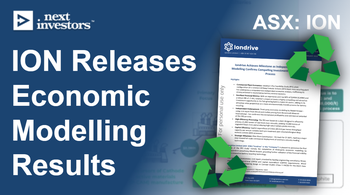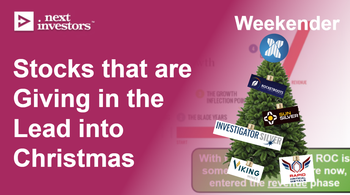Investment Memo:
Iondrive Ltd
(ASX:ION)
-
LIVE
Opened: 03-Dec-2024
Shares Held at Open: 26,785,000
What does ION do?
ION’s technology takes black mass (shredded used batteries) and recovers battery grade lithium, nickel, manganese and cobalt.
What is the macro theme?
There is a huge wave of EV batteries coming to the end of their lives.
Millions of tonnes of shredded batteries (black mass) need to be recycled, particularly in the EU which exports its black mass to Asia.
The EU is looking to ban exports of black mass.
Battery recycling companies in the EU could solve this problem.
It’s a market worth about $100B worth driven by 11M tpa of black mass.
Our Big Bet for ION
“ION re-rates to a +$150M market cap on successful large-scale production of commercial quantities of battery materials through its recycling process and/or by securing important partnerships in the recycling industry.”
NOTE: our “Big Bet” is what we HOPE the ultimate success scenario looks like for this particular Investment over the long term (3+ years). There is a lot of work to be done, many risks involved - just some of which we list in our ION Investment Memo. Success will require a significant amount of luck. There is no guarantee that our Big Bet will ever come true.:
Why did we invest in ION?
Solving a current and growing problem.
Electric vehicle growth is creating millions of tons of end-of-life batteries. +80% of battery recycling occurs in Asia. Europe and the USA are already struggling to acquire critical metals and they want to stop exporting their recyclable batteries (and precious battery metals) back to Asia ASAP.
Cleaner, greener, cheaper battery recycling process.
ION’s recycling tech uses non-toxic, typically biodegradable Deep Eutectic Solvent (DES). Conventional recycling technologies are much more energy and acid intensive. This means ION’s tech has the potential to be cheaper and more environmentally friendly.
Technology proven in large lab trials, now for a Pilot Plant.
ION’s tech has been de-risked in large lab trials with recoveries from pre-treated black mass of 89.1% lithium, 100% nickel, 98.6% cobalt and 98.4% manganese.
The company has published a PFS for a commercial scale 10,000 tonnes per annum plant. ION expects to have a smaller pilot plant operational in 2025 and work towards a commercial scale plant after that.
ION’s “Dream Team” that have worked in chemical processing across technology scale up, capital markets and commercial execution.
- Ebbe Dommisse (CEO): Worked as COO of Circa Group when it was a biomass waste recycling startup through to commercialisation. IPO’d on Norway’s stock exchange at a market cap of €194M.
- NEW ADDITION: Lewis Utting (Commercial Director): Former MD of SciDev (wastewater treatment), While Lewis was MD the stock went from 6.5c to $1.
- NEW ADDITION: Hugo Schumann (Non-Executive Director): Former CFO of Jetti Resources copper extraction technology. Hugo delivered the Series C ($50M) and Series D ($160M) rounds for the company which was last valued at $2.5BN in 2022. Jetti was backed by top industry investors like Freeport, BHP, Mitsubishi and Blackrock. Hugo also established the London office of the Apollo Group, a global natural resources VC firm.
Big money is backing recycling tech.
We have seen a few big deals for recycling technology companies in the last 12 months:
- Ascend Elements raised US$524M and also secured a $480M grant from the US Department of Energy (September 2023).
- Clyib recently raised €55M in what was the biggest recycling tech deal in the EU. The company had only been operational for 2 years before that deal… (May 2024).
- Descyle also raised €12M with backing from some high profile EU venture funds (November 2024).
Bottom of cycle pick-up in a strong macro thematic for the future.
Battery metals prices have come off from the 2021-2022 boom years for a number of reasons.
We see this as a counter-cyclical Investment with a relatively cheap entry point as a bet on battery metals prices running again. We expect to see demand for commercially viable recycling technology increase as battery metals prices increase.
The EU targets recycling and moves to ban black mass export to China.
The EU has legislated a goal that 15% of critical raw materials consumption comes from recycled content each year. The EU is making moves to classify black mass as a hazardous material in a move to limit China’s ability to import it. This could improve ION’s ability to source feedstock with Europe without being undercut by Chinese competition.
ION has joined a battery recycling value chain consortium in the EU.
ION has key industry partnerships within the EU including universities and industry groups. This will set the foundation for critical relationships that ION will need to build to (1) secure a reliable supply of feedstock (black mass) for its processing plant and (2) support with off-take agreements.
Tightly held stock and a small valuation, EV of just $7M.
Post money the company will have a cash balance of ~$9M and an enterprise value of ~$7M. The two biggest holders together own close to 40% of the company. Per the last annual report, more than 66% of the stock was held by top 20 shareholders. The largest shareholders appear to hold for the long term, and have supported past cap raises and the most recent raise. Sticky, large, supportive long term holders are very important for a small stock to succeed.
VUL success with innovative, clean European battery metals and tech story.
We have seen creative, clean, green tech solutions in battery metals supply work very well with our best ever Investment Vulcan Energy Resources. VUL is still up by over ~30x from our Initial Entry Price and has been rising over the last few months. The EU likes clean battery tech stories and it seems the market does too.
Innovation pipeline - more types of recycling tech for different critical metals.
ION has a strategic partnership with the University of Adelaide. ION will get first look at any new technologies developed under a $5M grant by the Australian Research Council which is overseen by the two professors that developed ION’s current DES recycling technology.
$100B battery recycling market by 2040.
By 2040 the volume of “end of life” battery projects is expected to generate 11M tonnes of black mass every year. This represents $100BN in recoverable value if it is able to be efficiently recycled. This resolves the “feedstock” issue for both ION and Europe to deliver a battery metals industry.
What do we expect ION to deliver?
Objective #1: Publish economics on recycling plant projects.
ION is currently undertaking an economic study to evaluate the NPV and IRR of its recycling plant. This will provide us with a much better picture of the potential economic upside of the project.
Milestones
 Economic modelling of Net Present Values
Economic modelling of Net Present Values
Objective #2: Design and build pilot plant
We want to see ION build its pilot plant. This pilot plant will set the stage for ION to better develop its technology, and provide potential samples to offtake customers.
Milestones
 Complete design of pilot plant
Complete design of pilot plant
 Lock in EPCM contract for the build
Lock in EPCM contract for the build
 Start construction on pilot plant
Start construction on pilot plant
 Complete pilot plant construction
Complete pilot plant construction
Objective #3: Successful commissioning of pilot plant
Once the plant is constructed we want to see if ION’s technology can repeat the successful recoveries of critical materials at a larger scale.
Milestones
 Pilot plant commissioned
Pilot plant commissioned
 First recovery results from pilot plant
First recovery results from pilot plant
 Second recovery results from pilot plant
Second recovery results from pilot plant
 Third recovery results from pilot plant
Third recovery results from pilot plant
Objective #4: Corporate deals to secure business model
While the pilot plant is being constructed we want to see ION secure corporate deals, offtake agreements, black mass supply, industry partnerships and funding/financing.
Milestones
 Industry deal 1
Industry deal 1
 Industry deal 2
Industry deal 2
 Industry deal 3
Industry deal 3
 Industry deal 4
Industry deal 4
 Industry deal 5
Industry deal 5
Funding and dilution risk
ION is a pre-revenue small cap company. This means that ION may need to raise funds in the future via capital raises that may incur dilution to shareholders.
Scale up / technology risk
There is no guarantee that the Pilot Plant is able to replicate the results from the large lab study. Also “feedstock reliability” both in terms of supply and consistency of material is a big risk for ION to scale up its operations.
Commercial/Sales risk
Product qualification for batteries with OEMs takes a long time. There is no guarantee that ION can sell its product through offtake agreements or that it can produce something that is commercial and on spec for its customers. If offtakes are delayed it can impact the ability of ION to secure further financing for a commercial scale plant.
Regulatory risk
ION wants to build its first plant in Europe to take advantage of the Critical Raw Materials act and potential export bans of Black Mass. If these regulatory tailwinds are delayed, don’t materialise or are not enforced, then it may negate some of the regulatory edge that ION has in the market. The same goes for the IRA in the US.
Market risk
There is always a possibility that the broader market sells off dragging ION shares with it. Or alternatively there could be sector specific pain ahead for the tech industry, hurting companies like ION.
What is our investment plan?
We plan to hold a position in ION for the next 3 years (and beyond) as it progresses its pilot plant and recycling technology.
We eventually may look to take some profits by selling up to ~20% of our holding (in line with our holding policy and escrow conditions) if the share price materially rerates on the company successfully delivering on the key objectives listed above.
Disclosure: Disclosure: S3 Consortium Pty Ltd (the Company) and Associated Entities own 26,785,000 ION shares at the time of publishing this Investment Memo. The Company has been engaged by ION to share our commentary on the progress of our Investment in ION over time.
















